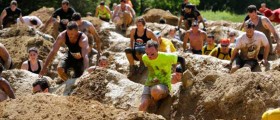Most of the races that I run are pretty small and use manual/non-chip timing. Just how does that work and why is my "official" time 2 ot 3 seconds slower than my watch time?
Loading...
Just put this in another post...
The conventional timers out there are typically a handheld unit that is running the official clock and someone punches in race numbers as they approach the finish and then another person simply clicks a button as people cross the line. The handheld syncs the two together. Then any last minute changes in finish position at the line are determined by the order of the tear off bib tabs which make staying in order of finish in the chute important.
So I'd say the difference is going to be sum of the microseconds difference from when the starter clicks the official clock and you click your watch and then the time they click your finish compared to when you do.
The conventional timers out there are typically a handheld unit that is running the official clock and someone punches in race numbers as they approach the finish and then another person simply clicks a button as people cross the line. The handheld syncs the two together. Then any last minute changes in finish position at the line are determined by the order of the tear off bib tabs which make staying in order of finish in the chute important.
So I'd say the difference is going to be sum of the microseconds difference from when the starter clicks the official clock and you click your watch and then the time they click your finish compared to when you do.
Loading...
They didnt use chips for the half marathon I ran just recently even though it was a fairly large race (~2000 people). The results were based on gun times (according to when the race actually starts, not when you actually cross the start line as in chip timing). I was about 15 seconds from the start line so my official time (on the results list) was about 15 seconds slower than the time that I had on my watch, which I started recording when I crossed the start line.
Loading...






